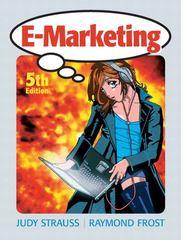Question
Founded in 2009 by Travis Kalanick, Uber provides transportation service in U.S., European, and Asian cities. In the year 2014, its gross revenues were $2.957
Founded in 2009 by Travis Kalanick, Uber provides transportation service in U.S., European, and Asian cities. In the year 2014, its gross revenues were $2.957 billion, net revenue after commissions and incentives, $495 million, cost of revenue, $400 million, operating expenses, $661 million, for EBIT of -$565 million. The original Uber model of operations was for the driver to use her/his own vehicle and offer services as and when they liked. The Uber webpage to drivers emphasizes, "Drive your own car using the Uber Partner app to find riders in your area. Set your own schedule. Get paid weekly." More recently, Uber has arranged for drivers to rent cars so as to provide Uber services. Uber clients book and pay for rides through the smartphone. After each ride, the Uber client rates the driver on a scale from 1 to 5. If a driver's rating falls below a particular level, Uber discontinues her/him from offering the service. Uber also allows drivers to rate clients. In January 2015, Uber extended fare cuts from the largest U.S. markets to 48 more cities. Uber asserted that the lower fares would benefit clients and drivers: "with the increased demand, drivers' income goes up as well. More demand turns into significantly more efficiency for the driver, more trips for every hour, and more earnings for every hour on the road". By contrast with Uber, whose drivers provide service with private cars, the Chinese services, Didi Dache (backed by Tencent) and Kuai Di Dache (backed by Alibaba) are smartphone-based applications to book taxis. In 2015, faced with competition from Uber (backed by search engine Baidu), Didi Dache and Kuai Di Dache merged. Following the merger, they continue to operate as separate services.
(a) What economic inefficiencies does the original Uber operating model exploit? How does your answer change for drivers who rent cars to provide Uber services? Compare the economic inefficiencies addressed by Uber vis--vis Didi Dache.
(b) What economic concept relates a cut in prices to an increase in demand? Explain how to use this concept to calculate the change in revenue from a 1% cut in prices. In Chicago, the reduction of fares by 23% led to 12% increase in revenue. What do these data imply about the concept in (b)?
(c) On a figure with dollars per hour on the vertical axis and hours of labor supplied on the horizontal axis, please sketch the driver's marginal benefit from providing labor. Note: If the driver supplies more hours, she raises the probability of getting work, but at a diminishing rate.
(i) Explain how a reduction in the fare affects the marginal benefit from providing labor. Consider both the direct effect of the fare and the indirect effect (lower fare attracts more customers and raises the probability that the driver gets work).
(ii) From a driver's viewpoint, what is the optimal quantity of labor to supply?
(iii) Intuitively, does an increase in earnings necessarily make drivers better off?
Step by Step Solution
There are 3 Steps involved in it
Step: 1

Get Instant Access to Expert-Tailored Solutions
See step-by-step solutions with expert insights and AI powered tools for academic success
Step: 2

Step: 3

Ace Your Homework with AI
Get the answers you need in no time with our AI-driven, step-by-step assistance
Get Started


